ROLAND DJ-505
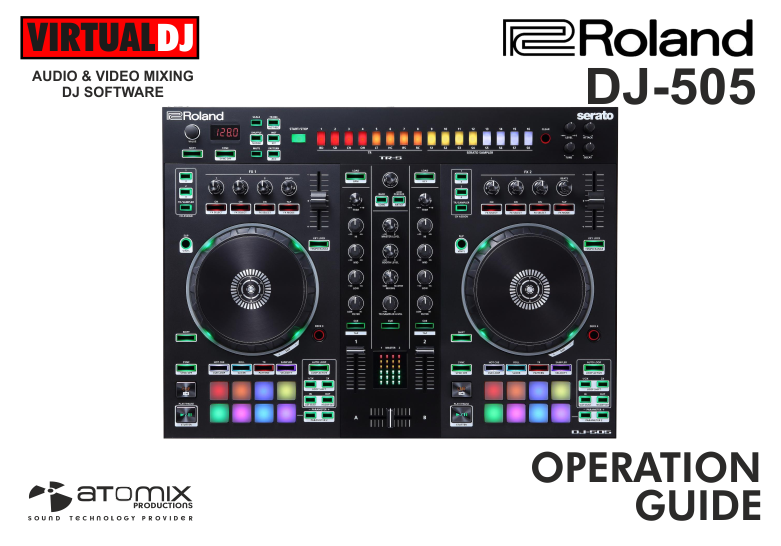
SETUP
Firmware & Drivers
Firmware : Update the firmware of the unit to the latest available version from https://www.roland.com/us/support/by_product/dj-505/updates_drivers/
Drivers :
Windows : Your computer automatically downloads* the Windows(R) 10 driver from the Internet when a product requiring the driver is connected to the computer. See further details at https://www.roland.com/us/support/by_product/dj-505/updates_drivers/
* Under normal conditions, the driver installation is completed in several minutes. It may take about 10 minutes depending on the Internet connectivity or if there are other drivers being installed for other devices.
Mac OSX : Download and install the Mac OSX Driver from https://www.roland.com/us/support/by_product/dj-505/updates_drivers/
VirtualDJ 8 Setup
Once VirtualDJ is opened, a Connect Window will appear. Login with your virtualdj.com account’s credentials.
A Pro Infinity or a Pro Subscription License is required to use the Roland DJ-505. Without any of the above Licenses, the controller will operate for 10 minutes each time you restart VirtualDJ.
https://www.virtualdj.com/buy/index.html
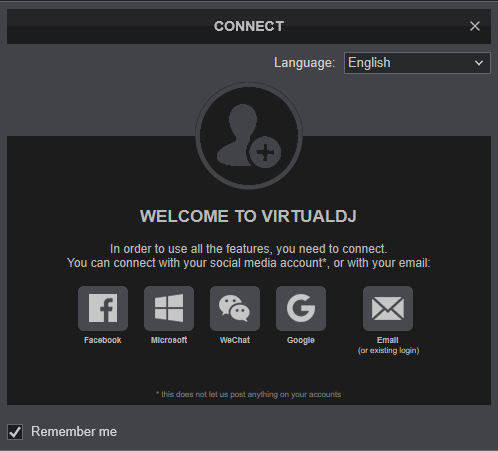
Click on the DJ-505 button in order VirtualDJ to apply the pre-defined audio configuration (speakers need to be connected to the rear side of the unit in this case)
Click to OK

The unit is now ready to operate.
MIDI Operation
The unit should be visible in the MAPPING tab of Settings and the “factory default” available/selected from the Mappings drop-down list.
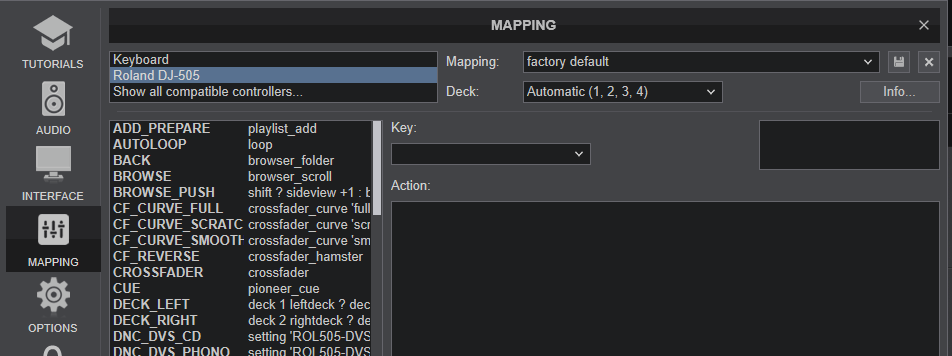
The factory default Mapping offers the functions described in this Manual, however those can be adjusted to your needs via VDJ Script actions.
Find more details at https://www.virtualdj.com/wiki/VDJ8script.html
AUDIO Setup
The unit has a pre-defined Audio setup and a special button in the AUDIO tab of Config to provide that.
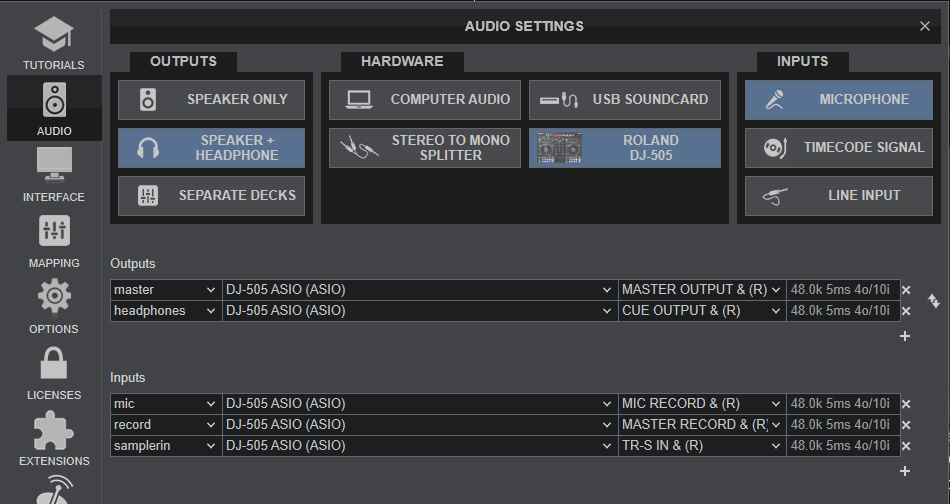
For further software settings please refer to the User Guide of VirtualDJ 8.
https://www.virtualdj.com/manuals/virtualdj8/index.html
LAYOUT

S SHIFT. Hold this button down to access secondary functions of the Roland DJ-505
The functionality of each button, knob and slider per section (as shown in the image above) will be explained in detail in the following chapters
A Mixer & Browser Controls
B Deck Controls
C Performance Pads
D Effects
E Sequencer
F Front & Rear panels
MIXER & BROWSER CONTRLOLS

- CROSSFADER: Blends audio between the left and right mixer channels.
- VOLUME: Alter the output Volume of Left/Right Mixer Channel.
- VU-METER: The 2 middle series of leds Indicate the level of the Master Output. The left and right series of leds indicate the pre-fader level of the Left and Right selected Decks respectively.
- CUE (CH PFL). Press this button to send Left/Right channel's pre-fader signal to the Headphones Channel for monitoring. When engaged, the button will be lit.
Hold SHIFT down and then use the CUE buttons to manually Tap on Tempo for VirtualDJ to calculate a different Tempo and Phase Beat-grid. - CUE (SAMPLER PFL). Press this button to send Sampler signal to the Headphones Channel for monitoring. When engaged, the button will be lit.
- FILTER. Use this knob to apply a High/Low-Pass Filter to the Left/Right mixer channel (middle position is Off position - no Filter is applied).
- * EQ-LOW. Adjust the Low (Bass) frequencies of Left/Right mixer channel.
- * EQ-MID. Adjust the Mid (Middle) frequencies of Left/Right mixer channel.
- * EQ-HI. Adjust the High (Treble) frequencies of Left/Right mixer channel.
- TRIM: Adjusts the pre-fader output level (gain) of Left/Right channel mixer.
- LOAD: Press this button to load the selected track from the Browser to the Left/Right selected Deck. Double-press (press twice fast) to clone the track from the opposite deck to the Left/Right Deck.
Hold SHIFT down and then use the left button to sort the tracks of the Files list by BPM (toggles between descending and ascending order).
Hold SHIFT down and then use the right button to sort the tracks of the Files list by Key (toggles between descending and ascending order). - BROWSE Knob/push :
Knob: Scrolls through files or folders. When SHIFT is pressed it scrolls faster (+/- 5 tracks/folders)
Push the knob to select (focus) the next Browser window (Folders List -> Files List -> Sideview and cycle back).
Hold SHIFT down and then push the BROWSE knob to cycle the Sideview List views (Automix, Sidelist, Karaoke, Sampler and Shortcuts) - BACK : Use this button to set focus to the Folders List. When focus is on the Folders list, use this button to expand/collapse sub-folders
Hold SHIFT and then use this button to sort Browser tracks by Title - ADD PREPARE : Use this button to add the selected track from the Songs List to the Automix List.
Hold SHIFT and then use this button to sort Browser tracks by Artist - MASTER LEVEL : Adjusts the level of the Master Output (Connections at the rear panel). Hardware operation but its movement is visible on VirtualDJ GUI.
- BOOTH LEVEL : Adjusts the level of the Booth Output (Connections at the rear panel).
- PHONES MIXING: Turn to mix between Cue and Program in the Headphone channel. When all the way to the left, only channels routed to the Headphones channel (via the CUE buttons) will be heard. When all the way to the right, only the Program mix will be heard.
- TR/SAMPLER LEVEL : Adjusts the level of the Sampler Output (includes the TR Sequencer and the VirtualDJ Sampler)
* Note: The device is offering Full Stems controls. See details at EQ Modes
DECK CONTROLS
S SHIFT.Hold this button down to access additional functionality for several buttons/knobs as described in this manual.
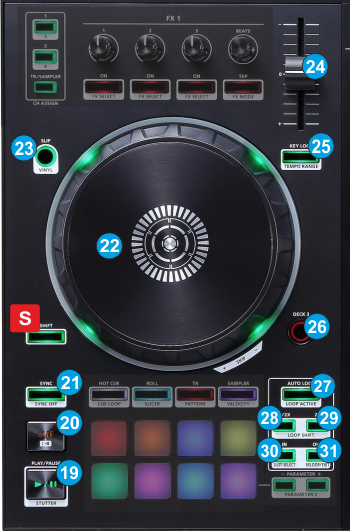
- PLAY: Play/Pauses the track. Hold SHIFT and then press this button to play the track in Stutter mode (while pressed)
- CUE: When the Deck is paused, you can set a temporary Cue Point by moving the Platter to place the Audio Pointer at the desired location and then pressing the Cue Button. During playback, you can press the Cue Button to return the track to this Cue Point. (If you did not set a Cue Point, then it will return to the beginning of the track.). If the Deck is paused, you can press and hold the Cue Button to play the track from the Temporary Cue Point. Releasing the Cue Button will return the track to the temporary Cue Point and pause it. To continue playback without returning to the Temporary Cue Point, press and hold the Cue Button, then press and hold the Play Button, and then release both buttons.
Hold SHIFT and then press this button to return to the beginning of the track - SYNC: Syncs the deck with the Master Deck. The Master Deck selection is made automatically by VirtualDJ, mostly depending on the Deck that is playing out in Master.
Hold SHIFT and then press this button to manually set a deck as Master Deck and force all other decks to sync to the Master Deck when SYNC is used. To return to the automatic selection, press again the button on the deck that is currently lit. - JOG: Touch sensitive platter for scratching or bending. When in Vinyl mode, use the upper part of the jogwheel to scratch and the outer part to bend. When in Bend mode (Vinyl mode is disabled), use any part of the jogwheel to bend.
Hold SHIFT and use the JOG in Seek (Search) mode. - SLIP: Use this button to enable Slip Mode on Left/Right deck. Several software functions (such as Jogwheel movements, HotCues and Loops) will apply temporary on the track, and the track will return to the position it would have been when those functions are not triggered.
Hold SHIFT down and then use this button to toggle between the CD (Bend) and Vinyl (Scratch) modes for the Jogwheel - PITCH : Pitch fader to adjust the Tempo of the track.
- KEYLOCK : Use this button to enable/disable Key-Lock (Master Tempo). When enabled, the Key of the track will retain its value when the Tempo of the track is changed.
Hold SHIFT down and then use this button to select the next available % range for the Pitch fader. - DECK SELECT: Use these buttons to select a Deck for the left and right side to control. The Left side of the DJ-505 can control decks 1 or 3, and the Right side can control decks 2 or 4.
- AUTOLOOP: Press this button to enable/disable a seamless Loop of the selected size in beats.
Use the same button to exit a manual loop (when IN/OUT were used) - 1/2: Use this button to half the size of the Loop
When a Loop is enabled, hold SHIFT and then use this button to move the Loop back in time in steps equal to the size of the Loop. - X2: Use this button to double the size of the Loop
When a Loop is enabled, hold SHIFT and then use this button to move the Loop forth in time in steps equal to the size of the Loop. - IN: Use this button to set current track's position as the start point of a manual loop
When a Loop is enabled, use this button to enable the Loop In adjust mode and then use the Jogwheel to fine-adjust the start point of the Loop. Press the same button again to disable the adjust mode (will be also disabled if the loop is turned off via the AUTOLOOP button)
Hold SHIFT down and then use this button to enable/disable Smart Loop. When Smart Loop is enabled, a manual loop using the IN and OUT buttons will automatically snap to the nearest size in beats and become a seamless loop. - OUT: Use this button to set current track's position as the ending point of a manual loop and complete a manual loop. When a Loop is enabled, use this button to enable the Loop Out adjust mode and then use the Jogwheel to fine-adjust the ending point of the Loop. Press the same button again to disable the adjust mode (will be also disabled if the loop is turned off via the AUTOLOOP button)
Hold SHIFT down and then use this button to trigger (enable and jump to) the last triggered Loop.
PERFORMANCE PADS

Read further details about Pads in the VirtualDJ 8 manual
- PAD MODE. Press any of the 4 available Pad mode buttons to set the Pads to Hotcues, Loop Roll, TR or Sampler mode.
Press the same buttons twice to select the additional modes (Saved Loops, Loop, TR Velocity and Sampler Velocity)
Hold SHIFT and then press any of the 4 available Pad mode buttons to set the Pads to Cue Loop, Slicer, TR Pattern and KeyCue mode. All 12 available Pad modes are explained in details in this page - PADS. The 8 Pads offer different functionality depending on the selected mode.
- PARAMETER. Use these buttons to adjust the Parameters of the selected Pad mode.
HOTCUES
Each one of the 8 pad assigns a Hot Cue Point (1 to 8) or jumps the track to that Hot Cue Point (if assigned).
When a Hot Cue Button is unlit, you can assign a Hot Cue Point by pressing it at the desired point in your track. Once it is assigned, the Hot Cue Button will light on.
The color of the Pad depends on the setting nonColoredPOI or the assigned color from the POI Editor
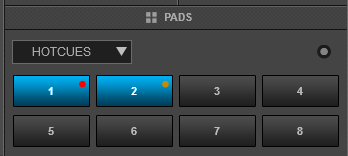
Hold SHIFT and then press a pad to delete its assigned Hot Cue Point.
Use the PARAMETER buttons (34) to jump the song to the previous/next assigned HotCue point.
Hold SHIFT and then use the PARAMETER buttons (34) to jump 1 beat backwards/forward.
SAVED LOOPS
Each one of the 8 pad represents a slot to save and recall a loop. Press a Pad to save (and trigger at the same time - if not already) a Loop at the current position. Hold the same Pad down for more than 2 seconds to delete the saved loop from the slot.
When a Loop is saved to a slot, use the same Pad to load* (enable) the saved loop, but not jump to its position if the loop is saved to a later position than the current one (load and prepare).
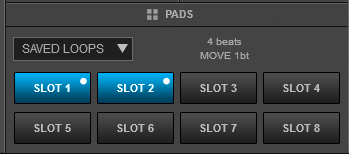
Hold SHIFT and then use the same Pad to load* (enable) the saved loop, and jump to its position.
*Note that only 1 Loop can be enabled each time.
Use the PARAMETER buttons (34) to half/double the size of the Loop.
Hold SHIFT and then use the PARAMETER buttons (34) to move the Loop back/forth in time by 1 beat steps..
CUE LOOP
In this mode each one of the 8 pads assigns a Hot Cue Point or jumps the track to that Hot Cue Point, but in both cases, it also triggers a Loop at that point (momentary or toggle depending on the selected mode from the Page menu). .
Hold SHIFT and then press a pad to stutter/jump to the Hotcue (loop will remain triggered)
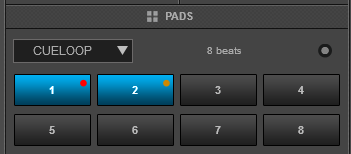
Use the PARAMETER buttons to half/double the size of the triggered Loop.
Hold SHIFT and then use the PARAMETER buttons to select the On/Off (Toggle) or Hold (momentary) Loop trigger mode.
By default the Cue Loops will be quantized. This can be turned off/on from the Page Menu on the GUI.
ROLL
Press one of the 8 pads to trigger a momentary Loop Roll. Once the Pad is released, the track will resume playing from the position it would have been if the Loop Roll was never triggered. The exit point will be visible on the waveform of the VirtualDJ GUI with an additional “running” play marker.
Hold SHIFT to get a ½, ¾, 1 and 2 beats Loop Roll sizes for the 4 low pads.
Use the Page menu to apply the Loop Rolls to Video.
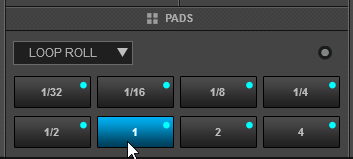
The PARAMETER buttons don't have any functionality in this mode.
LOOP
Press one of the pads to trigger an Auto Loop of a different size in beats, depending on the selected page. There are 6 different pages available with sizes starting from 1/32 up to 128 beats.
Use the PARAMETER buttons to select the previous/next page with the desired Loop sizes

Hold SHIFT and then use the PARAMETER buttons to change the behavior of the Loop pads, by selecting the On/Off (toggle), Hold (momentary – while pad is pressed) or the Roll mode (track will resume to the position it would have been once the pad is released)
SLICER
The 8 pads represent eight sequential beats—"Slices"—in the Beat Grid. The currently playing Slice is represented by the currently green lit pad. The light will move through the pads as it progresses through each eight-Slice phrase. Press a pad to repeat that Slice (hold it down if you want to keep looping it).
Once the Pad is released the track will continue to play from the position it would have been if the pad was never pressed.
Hold SHIFT and then use the Pads to repeat the memorized Slices (the Slices played/repeated last time)
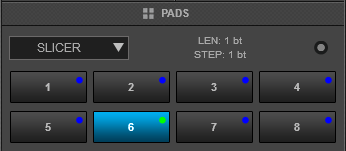
Use the PARAMETER buttons to adjust the length of the Loop applied to the slice. Hold SHIFT down and then use the PARAMETER buttons to adjust the step of the Slices
SAMPLER & SAMPLER VELOCITY
Each one of the 8 pads triggers a sample from the selected Sampler Bank of VirtualDJ. If a bank has less than 9 samples, both sides of the DJ-808 will control the same samples. If a bank has more than 8 samples, the left side of the DJ-808 will control samples 1 to 8 and the right side samples 9 to 16. The PAD will be lit if a sample slot is loaded and will blink if triggered.
Press the pads to trigger a sample. Depending on the selected trigger Pad mode, use SHIFT and the same pads to stop the sample.
Use the PARAMETER buttons to select the Sampler Bank (previous/next).
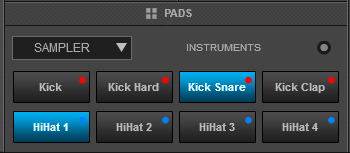
Hold SHIFT down and then the PARAMETER buttons to select the Trigger Pad mode (on/off, hold, stutter, unmute)
While the Sampler mode is selected (led is lit in violet), press the SAMPLER mode button again to set the PADs to Sampler Velocity mode (button will be lit in magenta) and automatically load the Sampler Pads page in VirtualDJ GUI
Same as in the Sampler mode, the Pads trigger a Sample from the selected Sampler Bank of VirtualDJ, but at the same time the output volume of each sample is controlled by the pressure applied on the Pad
Key-Cue mode
Hold SHIFT and then press the SAMPLER Mode button to set the Pads to Key-Cue mode (the led of the SAMPLER button will be lit in orange color). The KeyCue page will be then selected and displayed in the Pads section of the VirtualDJ skins.
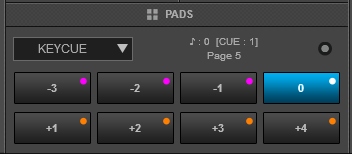
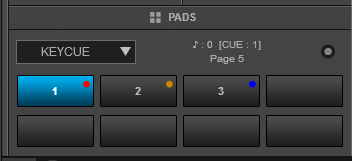
In this mode, the Pads trigger a selected Hotcue point (or the Temporary Cue if none selected or not available) at a selected Key semitone (from -7 to +7).
8 different pages/banks are offered with various semitone values to use and a 0 value (reset key to tis original value) is always offered in all pages.
Hold SHIFT and then select a Hotcue for the Key pads to trigger. Each time a Pad is pressed, the track will jump to that Hotcue point and will also alter the Key of the track to the value designated by it assigned value.
Use PARAMETER buttons -/+ to adjust the Key of the track without trigger a Hotcue.
Hold SHIFT and then use the PARAMETER buttons to select a different page/bank with different key semitone values.
TR
Press the TR mode button to set the PADs to TR mode (button will be lit in red).
This mode is a Hardware one and no Pad page will be loaded in the VirtualDJ GUI, nor the Pads in this mode send any MIDI signal, so cannot be assigned to any VirtualDJ operation.
In this mode the Instruments of the TR Sampler are assigned to the upper performance pads as follows.
Pad 1 : Bass Drum (BD)
Pad 2 : Snare Drum (SD)
Pad 3 : Closed HiHat (CH)
Pad 4 Open HiHat (OH)
The lower row of pads lets you play a roll on the instrument assigned to the Pad above it..
Press or hold down a performance pad. Pressing a pad in the upper row plays the instrument. Holding down a pad in the lower row plays a roll on the instrument. The spacing of the roll depends on how strongly you press the pad. The more strongly you press the pad, the shorter the spacing between strikes of the roll. You can use the PARAMETER [−] [+] buttons to change the roll variation.
TR VELOCITY
While the TR mode is selected (led is lit in red color), press the TR mode button again to set the PADs to TR Velocity mode (button will be lit in orange).
This mode is a Hardware one and no Pad page will be loaded in the VirtualDJ GUI, nor the Pads in this mode send any MIDI signal, so cannot be assigned to any VirtualDJ operation.
The upper 4 Pads operate exactly the same as in TR mode, with the difference that the volume of the Instruments depends on how strongly the Pads are pressed. The stronger you press the Pad, the louder the instrument’s volume.
While you hold down a pad in the lower row, the instrument plays a roll. The spacing of the roll depends on how strongly you press the pad. The more strongly you press the pad, the shorter the spacing between strikes of the roll.
TR PATTERN
Hold SHIFT down and then press the TR mode button to set the PADs to TR Pattern mode (button will be lit in green)
This mode is a Hardware one and no Pad page will be loaded in the VirtualDJ GUI, nor the Pads in this mode send any MIDI signal, so cannot be assigned to any VirtualDJ operation.
Use Pads 1 to 8 to select Patterns 1 to 8 for the TR Sampler.
Hold SHIFT down and then use the same Pads to select Patterns 9 to 16.
The same functionality if offered from the 16 TR buttons at the top when the PATTERN button is enabled.
EFFECT CONTROLS

Each one of the left/right FX unit offers Effect controls for the Left and Right assigned decks or TR Sampler and can operate in 2 modes. The Single Effects mode offers one effect slot but more parameters controls per effect. The Multi Effects mode offers 3 effect slots (to trigger more than 1 effect at the same time – chained effects). The selection between those 2 modes is done by pressing the TAP (41) button while SHIFT is held.
Single FX mode
Hold SHIFT down and then use the TAP (41) button to select the Single FX mode in the default GUI. The Single FX mode is selected by default on first launch
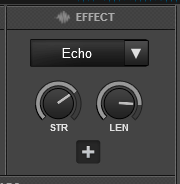

In this mode a single Effect is controlled with up to 6 Parameters and 3 Effect buttons. Only the first 2 Parameters are visible on the GUI. More Parameters and Effect buttons can be viewed in the FX GUI (opened from the + button on the GUI or using SHIFT+FX1 ON from the DJ-505)
- FX1 ON. Press this button to enable/disable the selected effect to the Left/Right selected deck.
Hold SHIFT down and then use this button, to open/close the FX GUI of the selected Effect. - FX2 ON. Press this button to select the previous effect from VirtualDJ Effects list. Hold SHIFT down and then use this button, to enable/disable the 1st effect button of the selected effect (if available).
- FX3 ON. Press this button to select the next effect from VirtualDJ Effects list.
Hold SHIFT down and then use this button, to enable/disable the 2nd effect button of the selected effect (if available). - FX1 knob. Controls the 1st effect parameter of the selected effect.
Hold SHIFT down to control the 4th effect parameter of the selected effect (if available). - FX2 knob. Controls the 2nd effect parameter of the selected effect.
Hold SHIFT down to control the 5th effect parameter of the selected effect (if available). - FX3 knob. Controls the 3rd effect parameter of the selected effect.
Hold SHIFT down to control the 6th effect parameter of the selected effect (if available).
Multi FX mode
Hold SHIFT down and then use the TAP (51) button to select the Multi FX mode in the default GUI.
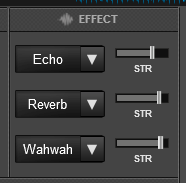

In this mode 3 different Effects can be applied and controlled with up to 2 Parameters for each FX slot. Only the first Parameter is visible on the GUI (and the 2nd Parameter while SHIFT is held on the DJ-505). More Parameters and Effect buttons can be viewed in the FX GUI (opened from the + button on the GUI)
- FX1 ON. Press this button to enable/disable the selected effect of FX slot 1.
- FX2 ON. Press this button to enable/disable the selected effect of FX slot 2.
- FX3 ON. Press this button to enable/disable the selected effect of FX slot 3.
- FX1 knob. Controls the 1st parameter of the selected effect of FX slot 1.
Hold SHIFT to control the 2nd parameter of the selected effect of slot 1. - FX2knob. Controls the 1st parameter of the selected effect of FX slot 2.
Hold SHIFT to control the 2nd parameter of the selected effect of slot 2 - FX3 knob. Controls the 1st parameter of the selected effect of FX slot 3.
Hold SHIFT to control the 2nd parameter of the selected effect of slot 3.
OTHER FX KEYS
- TAP While track is playing, tap this button on beat - at least 4 times - to manually set the tempo (BPM) of the loaded track.
Hold SHIFT down and then this button to toggle between the Single and Multi Effect modes. - BEATS Use this knob from the left side to select a Video Transition. Hold SHIFT down to adjust its Parameter (if available).
Push the left side knob to trigger the selected Video Transition.
Use this knob from the right side to select a Video Effect on Master. Hold SHIFT down to adjust its Parameter (if available).
Push the right side knob to trigger the selected Video Effect on Master. - FX ASSIGN 1/3 Use this button to copy the selected effects from Deck 1 (or Deck 3 if SHIFT is pressed) to the Left/Right Deck.
E.g. press the FX1 ASSIGN button on Right side to copy the effects from Deck 1 to the Right Deck. - FX ASSIGN 2/4 Use this button to copy the selected effects from Deck 2 (or Deck 4 if SHIFT is pressed) to the Left/Right Deck.
E.g. press the FX2 ASSIGN button on Left side to copy the effects from Deck 2 to the left Deck. - TR ASSIGN Use this button to assign the left/right FX unit to the TR/Sampler. When enabled, the FX unit will control and apply Effects on the TR/Sampler signal.
Hold SHIFT down and then use this button to set the Pads section to the Sampler FX mode and the corresponding Pad page to be loaded at the Pads section of VirtualDJ GUI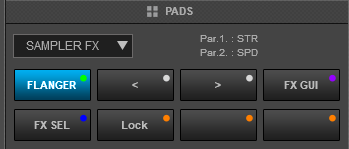
TR SAMPLER

This is a 16-step sequencer. It lets you create a rhythm track using the sounds of the Roland TR-909/TR-808/TR-707/TR-606 rhythm machines or samples from the selected VirtualDJ Sampler Bank, or perform rhythms by striking the performance pads.
- VALUE. Changes the value of settings such as tempo, pattern scale, or shuffle.
Note, that the Tempo of the TRS will always match the tempo of the Master Deck, so when a deck is playing, the tempo of the TRS cannot be changed. - LCD. Displays the tempo of the TRS along with some other info.
- SYNC Press this button to turn on the synchronization of the phase of the Sequencer with the phase of the Master Deck.
Hold SHIFT down and then press this button to turn off the phase synchronization. - SCALE Selects one of the following choices as the time value of one step. Press this button and then use the VALUE knob to select one of the following scale values
8th note triplet : Three steps will be one beat.
16th note triplet : Six steps will be one beat.
16th note : Four steps will be one beat.
32nd note : Eight steps will be one beat.
Hold SHIFT and then press the button to specify the last step. - SHUFFLE Adjusts shuffle (rhythmic swing).
Hold SHIFT down to set the nudge setting - MUTE Mutes the selected instrument
- TR-REC Lets you step-record a pattern.
Hold SHIFT down and then use this button to realtime-record a pattern using the performance pads (INST REC). - INST. Select the instruments when using TR-REC
Hold SHIFT and then press this button (will blink) to set the kit for instruments or switches the Sampler Banks of VirtualDJ. Use buttons 13 - 16 to select Banks 1 to 4 - PATTERN Lets you select rhythm patterns 1–16.
Hold SHIFT and then use this button to add an accent to the step when using TR-REC. - START/STOP : Plays/stops the pattern.
[SHIFT] +[START/STOP] : Replays the currently-playing pattern from the beginning. - TR-S pads [1]–[16] Use these buttons to turn steps on/off or to select patterns, instruments or select VirtualDJ Samples as instruments.
- CLEAR Deletes the content recorded by TR-REC for a specific instrument, or deletes the pattern.
- LEVEL Adjusts the volume of the instrument selected by the [BD] / [SD] / [CH] / [OH] buttons.
- ATTACK Adjusts the strength of the attack if the [BD] button is selected, or adjusts the sound of the snare rattle if the [SD] button is selected. * If the [CH] or [OH] button is selected, this knob does nothing.
- TUNE Adjusts the tuning (pitch) of the instrument selected by the [BD]/[SD]/[CH]/[OH] buttons.
- DECAY Adjusts the decay of the instrument selected by the [BD]/[SD]/[CH]/[OH] buttons.
Note : Most of the following information have been copied from the official Roland DJ-505 Manual
Read further details about the TR Sampler in the Roland DJ-505 manual
FRONT & REAR PANELS

- HEADPHONES SOCKET. Connect your 1/4" or 1/8" headphones to this output for cueing and mix monitoring.
- HEADPHONES VOLUME. Adjusts the volume level of the headphone output.
- CROSSFADER CURVE. Switches the response curve of the cross fader.
- CROSSFADER REVERSE. Reverses the crossfader operation.
- INPUT SELECT: Select the input source for each mixer channel.
CH1/CH2
PC : The sound loaded into VirtualDJ Left/Right Deck is the source. Select this if you’re using DVS (Timecodes).
LINE : The line level input is the source *.
PHONO : The phono level (MM type cartridge) input is the source *.
* Note: For LINE/PHONO positions to work and route theur respective signal to a VirtualDJ deck (and MASTER Output), line in(puts)s need to be added to VirtualDJ Audio setup. See advanced Setup - MIC LEVEL. Adjust the output level of the Microphone Input

- USB. This USB connection sends and receives audio and control information from a connected computer.
- MIDI OUT This connection outputs MIDI messages such as MIDI clock.
- MIC INPUT. Connect your microphone to this socket using TRS plug type.
- MIC SENS Adjusts the mic input sensitivity.
- INPUT (CH 1–CH 2) These sockets input sound to mixer channels 1 & 2. Both Inputs support line and phono inputs. The selection is done via the unit's system settings. Please see Advanced Setup page.
- MASTER OUT XLR (Balanced) Use XLR cables to connect your powered speakers or power amp here. The level of this output is controlled by the MASTER LEVEL knob at the top panel
- MASTER OUT RCA (secondary unbalanced output) Use RCA cables to connect your powered speakers or power amp here. The level of this output is controlled by the MASTER LEVEL knob at the top panel
- BOOTH OUT (L / R) jacks These are the output jacks for booth monitoring. The level of this output is controlled by the BOOTH MONITOR knob at the top panel
- POWER: Use this switch to turn the unit on and off. Turn on DJ-505 after all input devices have been connected and before you turn on amplifiers. Turn off amplifiers before you turn off the DJ-505
- DC-IN: Use the included power adapter to connect DJ-505 to a power outlet.
ADVANCED SETUP
MICROPHONE
The signal of the Microphone Input is directly routed to the Master Output of the Roland DJ-505 and it is also included in the special Record Input, so you will find that the Microphone is working properly (and recorded as well), regardless if you have enabled this via the MIC ON button from the Master panel of VirtualDJ or not, or even if you exclude the "mic" line from the default audio configuration of VirtualDJ.
The microphone input is necessary to be included in the Audio setup and enabled from the ON button in VirtualDJ, only in case you need to apply software Effects to this input.
In order to do this, you will need to route the Microphone input to a VirtualDJ deck, by assigning the action deck x linein 'mic' (where x is the number of the deck that you wish to route the mic to) to a keyboard/custom button
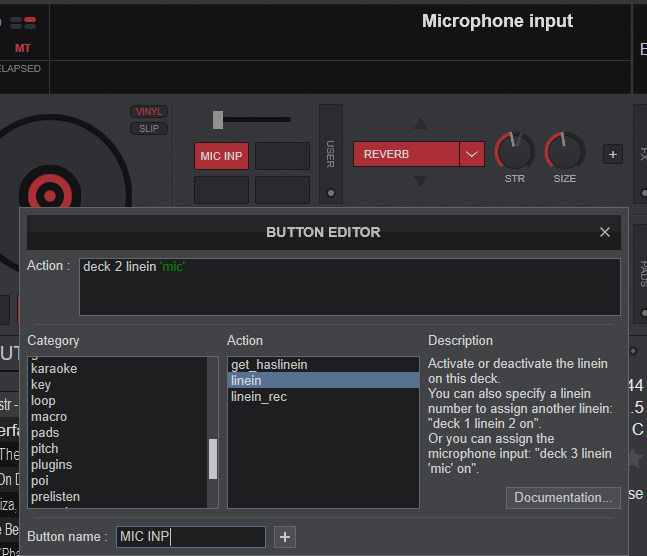
STAND-ALONE - EXTERNAL LINE/PHONO INPUTS
Audio from devices such as a DJ player or turntable (analog) can be input directly to the rear panel INPUT (CH 1 & CH 2) RCA sockets, and mixed by the DJ505’s mixer section. The input is routed to a VirtualDJ deck*, so you can also apply VirtualDJ effects to the external audio inputs and also include to your recording via VirtualDJ.
For that you will need to open Audio Setup of VirtualDJ and click on the LINE INPUT button at the top, so that VirtualDJ automatically adds 2 linein lines in your Audio Setup. Press APPLY.
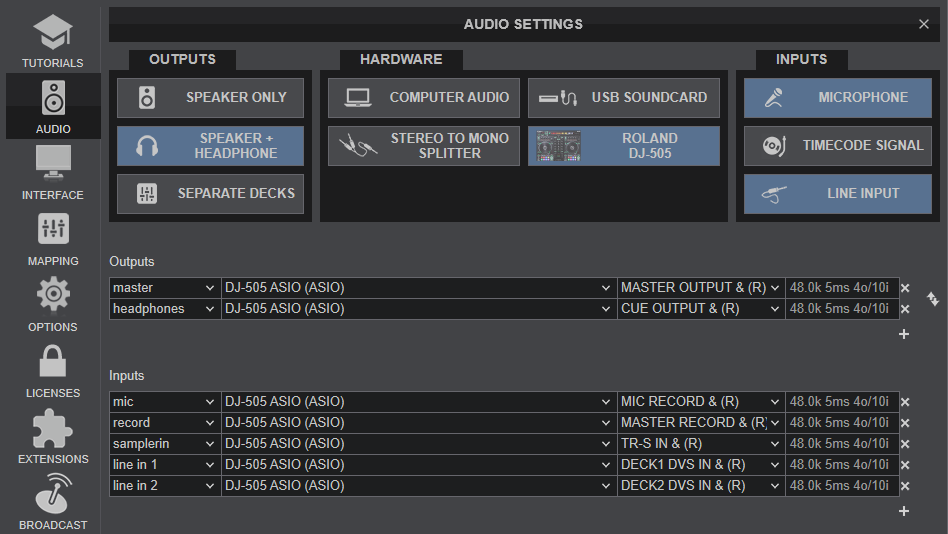
*Note : Line Inputs and Timecode (DVS) require a Pro Infinity or a Pro Subscription license
- Connect your media source to any of the INPUT CH RCA sockets.
- Use the
knob and channel fader to adjust the output level - You can use the [HI], [MID], and [LOW] knobs to adjust the volume of the high, mid, and low-frequency regions.
- You can use the [CHANNEL FX] buttons to apply effects.
- You can operate the effect section to apply VirtualDJ effects.
When a Channel is set back to PC, the track which was loaded when the same channel was set to LINE/PHONO, will be loaded again.
TIMECODE (DVS)
The audio interface of the Roland DJ-505 offers 2 stereo inputs, that can be used as Timecode Inputs (DVS)*.
- Connect your DVS unit (CD player with Timecode CD or turntable with Timecode Vinyl) to the appropriate INPUT at the rear panel. Note that a combination of both DVS signal types cannot be used. You will need to use either 2 Timecode Vinyl or 2 Timecode CDs.
- Select your Timecode Input type, from the OPTIONS tab of VirtualDJ Settings. Selection is saved across sessions.
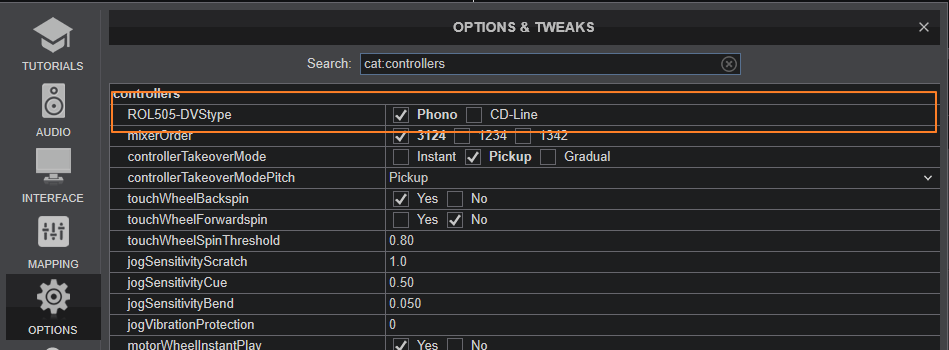
- Set the INPUT SELECT of this channel set to USB/PC at the front panel.
- Remove the Line In lines from Audio Setup (if added) and press the TIMECODE button in the Audio Setup of VirtualDJ so that the 2 Timecode lines are added to Audio Setup
- press APPLY
- Use the TIMECODE ON buttons from VirtualDJ GUI to select on which VirtualDJ deck your Timecode signal will apply to
In the following example we are using the 2 mixer channels for DVS
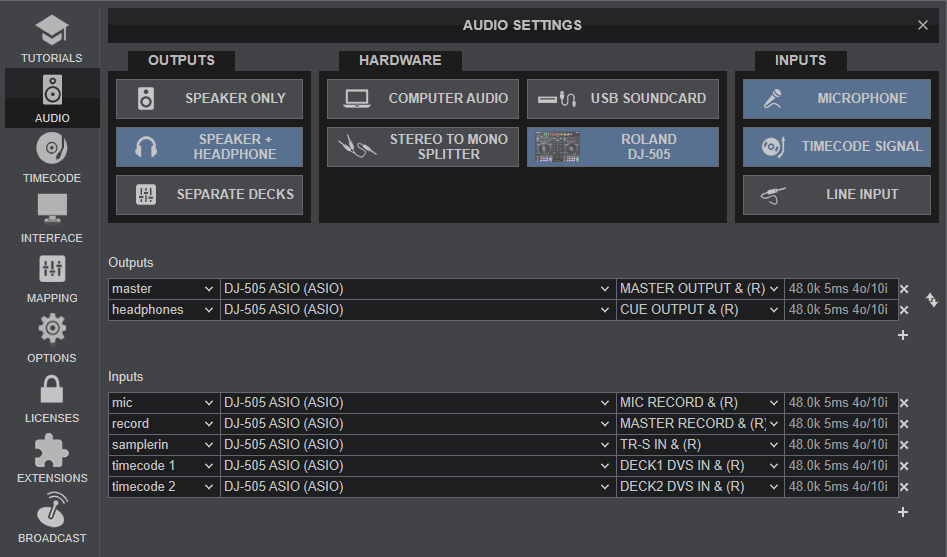
*Note : Line Inputs and Timecode (DVS) require a Pro Infinity or a Pro Subscription license
